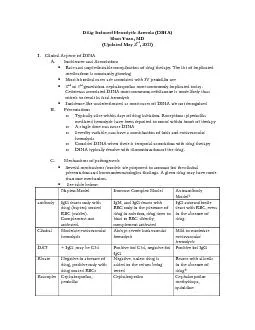

Shan Yuan MD Updated May 2 nd 2011 I Clinical Aspects of DIHA A Incidences and Associations R are and unpredicatable complication of drug therapy The list of implicated medications is con ID: 844523
Download Pdf The PPT/PDF document "Drug Induced Hemolytic Anemia DIHA" is the property of its rightful owner. Permission is granted to download and print the materials on this web site for personal, non-commercial use only, and to display it on your personal computer provided you do not modify the materials and that you retain all copyright notices contained in the materials. By downloading content from our website, you accept the terms of this agreement.
1 Drug Induced Hemolytic Anemia (DIHA) S
Drug Induced Hemolytic Anemia (DIHA) Shan Yuan, MD (Updated May 2 nd , 2011) I. Clinical Aspects of DIHA A. Incidences and Associations R are and unpredicatable complication of drug therapy. The list of implicated medications is constantly growing Most historical cases are associated with IV penicillin use 2 nd or 3 rd generation. cephalosporin s most commonly implicated today. Cefote tan associated DIHA most common ; ceftriaxone is more likely than others to result in fatal hemolysis Incidence like underestimated as mo st cases of DIHA are not recognized B. Presentations o Typically arise within days of drug initiation. Exceptions: piperacilin mediated hemolysis have been reported to occur within hours of therapy o A single dose can cause DIHA o Severity variable, can have a comb ination of intra and extravascular hemolysis o Consider DIHA when there is temporal association with drug therapy o DIHA typically resolve with discontinuation of the drug. C. Mechanisms of pathogenesis Several mechanisms /models are proposed to account for the c linical presentation and immunohematologica findings. A given drug may have more than one mechanis m . See table below: Hapten Model Immune Complex Model Autoantibody Model * antibody IgG reacts only with drug (hapten) coated RBC (carrier) . Complement not activated. IgM, and IgG reacts with RBC only in the presence of d rug in solution, d rug does to bind to RBC directl y, complement activated IgG autoantibodie react with RBC, even in the a
2 bsence of drug . Clinical Moder
bsence of drug . Clinical Moderat e extravascular hemolysis Abrupt s evere intravascular hemoly s is Mild to moderate extravascular hemolysis DAT + IgG, may be C3d Positive for C3d, negative for IgG Positive for IgG Eluate Negative in absence of drug, positive only with drug coated RBCs Negative, unless drug is added to the serum being tested Reacts with all cells in the absence of drug * Examples Cephalosporins, penicllin Cephalosporins Cephalosporins methyldopa, quinidine * Antibodies formed in th e autoantibody model have serolo gical findings indistinguishable from W AIHA - panreactive with +auto control. Selecting compatible units may require additional procedures as described for WAIHA, and all donor units will be incompatible II. Serological Findings (Also see above) A. DAT positive for IgG or complement or both B. Routine antibody screen/ID and eluate will be negative C. Requires clinical suspicion. Sample should be sent to reference laboratory for drug - specific antibody testing. Two formats o Specific drug is added to the patient serum being test, mixed with reagent RBCs o Pati ent serum is mixed with reagent RBCs precoated with drug in question III. Transfusion Considerations A. Transfusion is needed in severe cases B. In most cases, the drug - induced antibody does not interfere with pretransfusion compatibility testing. Exception: Antibodi es formed through the anutoantibody model C. If DIHA considered, the implicated drug should be discontinued ASAP to allow resolution of the DIHA